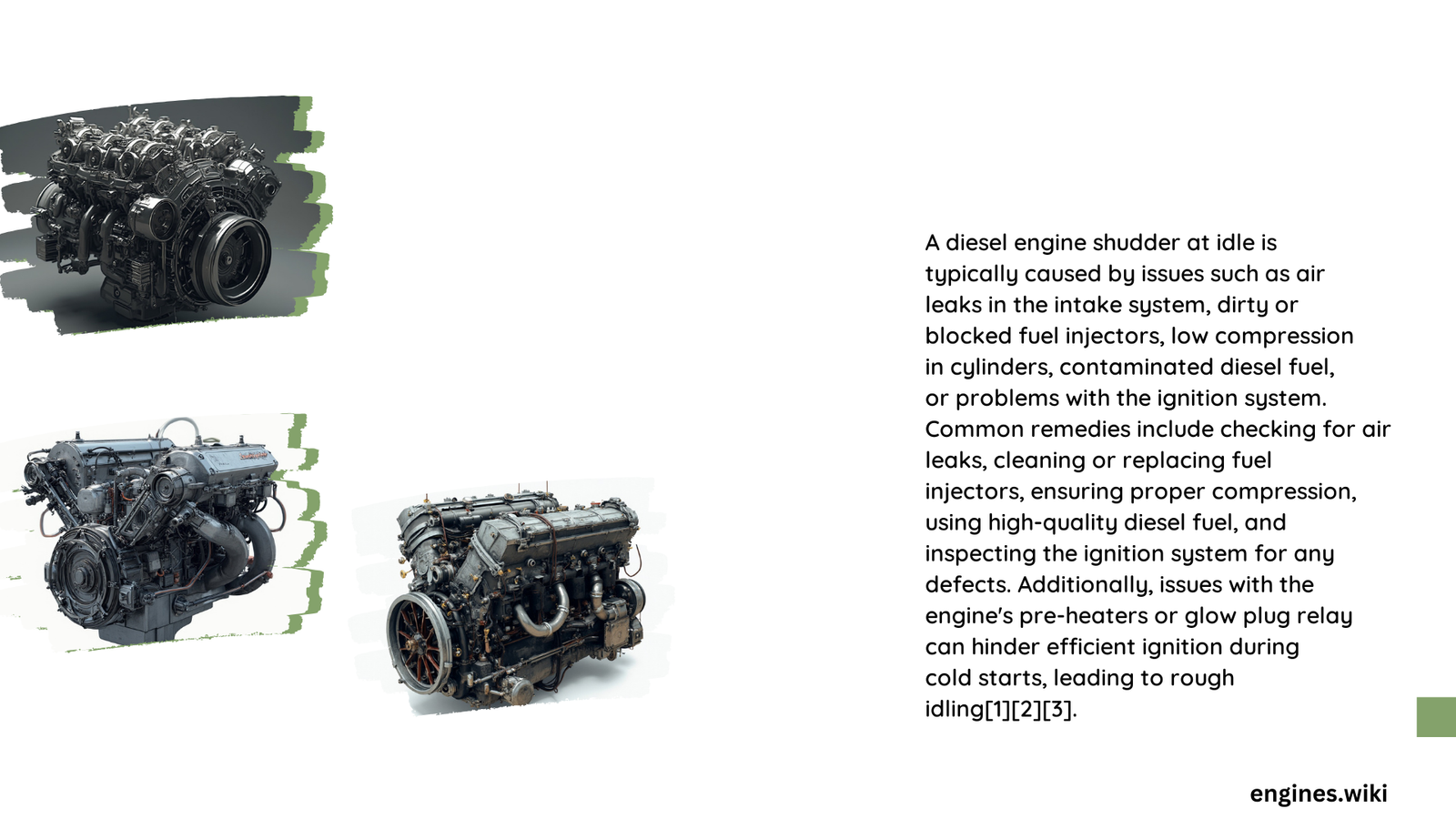Diesel engine shudder at idle is a common issue characterized by excessive vibration when the engine is running at low RPMs. This problem can stem from various factors, including combustion irregularities, mechanical wear, and system malfunctions. Understanding the root causes and implementing proper diagnostic techniques are crucial for effectively addressing this issue and maintaining optimal engine performance.
What Causes Diesel Engine Shudder at Idle?
Diesel engine shudder at idle can be attributed to several factors:
-
Combustion Forces and Structural Resonance: Unidirectional combustion forces and structural resonance contribute to vibrations in diesel engines. These forces lead to torsional, longitudinal, and mixed vibrations.
-
Valve Train Issues: Increased valve clearance can result in higher amplitude vibrations during valve opening and closing.
-
Piston Slap: Clearance between piston rings and cylinder liners can cause transversal vibrations, although these are often overshadowed by larger vibrations from the combustion process.
-
Fuel System Problems: Irregularities in fuel delivery or quality can lead to uneven combustion, causing engine shudder.
-
Worn Engine Mounts: Deteriorated engine mounts fail to dampen vibrations effectively, transmitting them to the vehicle body.
How Do Vibration Frequency and Amplitude Affect Diesel Engine Shudder?

The severity of diesel engine shudder is directly related to vibration frequency and amplitude:
-
Frequency: Torsional vibration frequencies vary based on engine RPM and cylinder count. For example, a four-stroke engine with a primary order of 4 at 6,500 RPM would have a torsional vibration frequency of 433 Hz.
-
Amplitude: Torsional vibration amplitude can be measured in degrees or inches. At 6,500 RPM, a crankshaft might twist and rebound through an amplitude of 0.7 degrees, or about 0.015 inches of movement.
These vibrations can resonate with vehicle components, amplifying the perceived shudder.
What Are the Typical Noise Levels Associated with Diesel Engine Shudder?
Noise levels associated with diesel engine shudder at idle typically range from 70-90 dB. However, it’s important to note that noise levels don’t always directly correlate with vibration intensity. Body resonances in the 30-300 Hz range often contribute to audible noise, which can be excited by various engine components.
How Does RPM Range Affect Shudder Severity?
Shudder severity often increases at lower RPMs, particularly when the transmission is about to downshift. This relationship between RPM and shudder severity can provide clues about potential causes:
- Low RPM Shudder: May indicate issues with engine-transmission mounts or mechanical alignments.
- Shudder Alleviation at Higher RPM: If manually increasing RPM reduces shudder, it could point to mount-related problems.
What Diagnostic Tools and Procedures Are Used to Identify Diesel Engine Shudder?
Effective diagnosis of diesel engine shudder requires a systematic approach using various tools and procedures:
- Vibration Analysis
- Tool: Vibration analyzer
- Cost: $500-$2,000
- Time: 1-3 hours
-
Purpose: Measure frequency and amplitude of vibrations
-
Visual Inspection
- Cost: $0-$100
- Time: 1-2 hours
-
Purpose: Check engine mounts, transmission mounts, and mechanical components for wear or damage
-
Compression Test
- Cost: $100-$300
- Time: 1-2 hours
-
Purpose: Verify combustion process integrity
-
Fuel System Check
- Cost: $100-$300
- Time: 1-2 hours
-
Purpose: Inspect for blockages or malfunctions in fuel delivery
-
Valve Train Inspection
- Cost: $200-$500
- Time: 2-4 hours
- Purpose: Check valve clearance and overall valve train condition
What Is a Step-by-Step Troubleshooting Guide for Diesel Engine Shudder?
Follow this systematic approach to diagnose and address diesel engine shudder:
- Identify Vibration Source
- Use vibration analysis to determine frequency and amplitude
-
Correlate findings with potential causes (e.g., valve train issues, piston slap, combustion problems)
-
Inspect Mechanical Components
- Check engine and transmission mounts for wear or damage
-
Examine driveshaft and universal joints for issues
-
Perform Compression and Fuel System Tests
- Conduct compression test to ensure proper combustion
-
Inspect fuel system for blockages or malfunctions
-
Adjust or Replace Components
- Based on findings, adjust or replace necessary components (e.g., valve train parts, piston rings, engine mounts)
Which Components Commonly Contribute to Idle Roughness and Shudder?
Several components can contribute to diesel engine shudder at idle:
| Component | Failure Rate | Replacement Cost | Impact on Shudder |
|---|---|---|---|
| Injectors | Moderate to High | $500-$1,500 per injector | Uneven combustion |
| Engine Mounts | High | $100-$500 | Vibration transmission to chassis |
| Fuel System | Moderate | $100-$1,000 | Uneven fuel delivery |
| Valve Train | Moderate | $200-$1,000 | Increased vibration |
| Piston Rings and Cylinder Liner | Moderate | $500-$2,000 | Piston slap |
How Can Diesel Engine Shudder Be Prevented?
Preventing diesel engine shudder at idle involves regular maintenance and proactive measures:
-
Regular Oil Changes: Maintain proper lubrication to reduce wear on engine components.
-
Fuel System Maintenance: Use high-quality fuel and replace fuel filters as recommended.
-
Timely Component Replacement: Replace wear items like engine mounts and injectors at recommended intervals.
-
Proper Engine Tuning: Ensure the engine is properly tuned for optimal combustion.
-
Regular Inspections: Conduct periodic inspections to catch potential issues early.
By following these preventive measures and addressing issues promptly, you can significantly reduce the likelihood of experiencing diesel engine shudder at idle.
